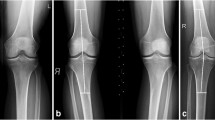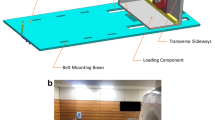Abstract
Objectives
To evaluate kinematic changes in menisci and tibiofemoral joint spaces in extension and flexion using asymptomatic volunteers using a wide-bore 3-T closed MRI system.
Methods
Twenty-two knees from asymptomatic volunteers were examined in knee extension and flexion using a 3-T MRI (sagittal 2D FSE T2-weighted sequence and sagittal 3D isotropic FSE proton density-weighted cube sequence). The meniscal positions, meniscal floating and flounce were evaluated. The widths of the medial and lateral tibiofemoral joint spaces and coronal tibiofemoral angles were measured.
Results
In the anteroposterior direction, meniscal extrusion was most frequently seen in the anterior horn of the medial menisci (100 %) in extensions (maximum 6.04 mm). Most of the menisci moved significantly to the posterior side from extension to flexion. The anteroposterior meniscal movement was the greatest for the anterior horn of the medial meniscus and least for the posterior horn of the medial meniscus. In the mediolateral direction, meniscal extrusion was seen in 52 % of the medial menisci in extensions (maximum 1.91 mm) and 29 % of lateral menisci in flexions (maximum 2.36 mm). From the extension to flexion, all medial and lateral menisci moved significantly to the lateral side. Meniscal floating was frequently observed in the posterior horn of medial menisci in extension. Meniscal flounce was frequently seen in lateral menisci in flexion with a widened lateral tibiofemoral joint space gap. The coronal tibiofemoral angle showed medial wedging in flexion, but not in extension.
Conclusions
Wide-bore 3-T closed MRI revealed significant kinematic changes in the menisci and tibiofemoral joint spaces in asymptomatic volunteers.






Similar content being viewed by others
Abbreviations
- FSE:
-
Fast spin echo
- PD:
-
Proton density
- AHMM:
-
Anterior horn of the medial meniscus
- PHMM:
-
Posterior horn of the medial meniscus
- AHLM:
-
Anterior horn of the lateral meniscus
- PHLM:
-
Posterior horn of the lateral meniscus
- ACL:
-
Anterior cruciate ligament
- PCL:
-
Posterior cruciate ligament
References
Kurosawa H, Fukubayashi T, Nakajima H. Load-bearing mode of the knee joint: physical behavior of the knee joint with or without menisci. Clin Orthop. 1980;149:283–90.
Rath E, Richmond JC. The menisci: basic science and advances in treatment. Br J Sports Med. 2000;34(4):252–7.
Shoemaker SC, Markolf KL. The role of the meniscus in the anterior-posterior stability of the loaded anterior cruciate deficient knee. Effects of partial versus total exicion. J Bone Joint Surg Am. 1986;68:71–9.
Vedi V, Williams A, Tennant SJ, Spouse E, Hunt DM, Gedroyc WM. Meniscal movement. An in-vivo study using dynamic MRI. J Bone Joint Surg (Br). 1999;81(1):37–41.
Noble J, Hamblen DL. The pathology of the degenerative meniscus lesion. J Bone Joint Surg (Br). 1975;57:180–6.
Allen CR, Wong EK, Livesay GA, Sakane M, Fu FH, Woo SL. Importance of the medial meniscus in the anterior cruciate ligament-deficient knee. J Orthop Res. 2000;18(1):109–15.
Brody JM, Lin HM, Hulstyn MJ, Tung GA. Lateral meniscus root tear and meniscus extrusion with anterior cruciate ligament tear. Radiology. 2006;239(3):805–10.
Costa CR, Morrison WB, Carrino JA. Medial meniscus extrusion on knee MRI: is extent associated with severity of degeneration or type of tear? AJR Am J. 2004;183(1):17–23.
Crema MD, Roemer FW, Felson DT, et al. Factors associated with meniscal extrusion in knees with or at risk for osteoarthritis: the Multicenter Osteoarthritis study. Radiology. 2012;264(2):494–503.
Boxheimer L, Lutz AM, Treiber K, Goepfert K, Crook DW, Marincek B, et al. MR imaging of the knee: position related changes of the menisci in asymptomatic volunteers. Invest Radiol. 2004;39(5):254–63.
Bikkina RS, Tujo CA, Schraner AB, Major NM. The “floating” meniscus: MRI in knee trauma and implications for surgery. AJR. 2005;184(1):200–4.
Park JS, Ryu KN, Yoon KH. Meniscal flounce on knee MRI: correlation with meniscal locations after positional changes. AJR. 2006;187(2):364–70.
Tokuhara Y, Kadoya Y, Nakagawa S, Kobayashi A, Takaoka K. The flexion gap in normal knees. an MRI study. J Bone Joint Surg (Br). 2004;86(8):1133–6.
Thompson WO, Thaete FL, Fu FH, Dye SF. Tibial meniscal dynamics using three-dimensional reconstruction of magnetic resonance images. Am J Sports Med. 1991;19(3):210–5. discussion 215-216.
Kawahara Y, Uetani M, Fuchi K, Eguchi H, Hayashi K. MR assessment of movement and morphologic change in the menisci during knee flexion. Acta Radiol. 1999;40(6):610–4.
Hayes CW, Brigido MK, Jamadar DA. Mechanism-based pattern approach to classification of complex injuries of the knee depicted at MR imaging. Radiographics. 2000;20:S121–34.
Bin SI, Kim JM, Shin SJ. Radial tears of the posterior horn of the medial meniscus. Arthroscopy. 2004;20(4):373–7.
Shefelbine SJ, Ma CB, Lee KY, et al. MRI analysis of in vivo meniscal and tibiofemoral kinematics in ACL-deficient and normal knees. J Orthop Res. 2006;24(6):1208–12.
Hunter DJ, Zhang YQ, Niu JB, et al. The association of meniscal pathologic changes with cartilage loss in symptomatic knee osteoarthritis. Arthritis Rheum. 2006;54(3):795–801.
Berthiaume MJ, Raynauld JP, Martel-Pelletier J, et al. Meniscal tear and extrusion are strongly associated with progression of symptomatic knee osteoarthritis as assessed by quantitative magnetic resonance imaging. Ann Rheum Dis. 2005;64(4):556–63.
McCarty WJ, Masuda K, Sah RL. Fluid movement and joint capsule strains due to flexion in rabbit knees. J Biomech. 2011;10;44(16):2761–7.
Yu JS, Cosgarea AJ, Kaeding CC, Wilson D. Meniscal flounce MR imaging. Radiology. 1997;203(2):513–5.
Freeman MA, Pinskerova V. The movement of the knee studied by magnetic resonance imaging. Clin Orthop Relat Res. 2003;410:35–43.
Muller W. The knee: form, function and ligament reconstruction. New York: Springer; 1983. p 8, 9, 145–150.
Wachowski MM, Walde TA, Balcarek P, et al. Total knee replacement with natural rollback. Ann Anat. 2012; 20;194(2):195–9.
Frosch KH, Floerkemeier T, Abicht C, et al. A novel knee endoprosthesis with a physiological joint shape. Part 1: biomechanical basics and tribological studies. Unfallchirurg. 2009;112(2):168–75.
Nägerl H, Frosch KH, Wachowski MM, et al. A novel total knee replacement by rolling articulating surfaces. In vivo functional measurements and tests. Acta Bioeng Biomech. 2008;10(1):55–60.
Pinskerova V, Johal P, Nakagawa S, et al. Does the femur roll-back with flexion? J Bone Joint Surg (Br). 2004;86(6):925–31.
Peduto AJ, Nguyen A, Trudell DJ, Resnick DL. Popliteomeniscal fascicles: anatomic considerations using MR arthrography in cadavers. AJR. 2008;190(2):442–8.
Kaiser J, Bradford R, Johnson K, Wieben O, Thelen DG. Measurement of tibiofemoral kinematics using highly accelerated 3D radial sampling. Magn Reson Med. 69(5):1310–6.
Acknowledgments
We deeply appreciate the help of our excellent MR technicians.
Conflict of interest
This work was supported by an INHA University research grant.
All authors in this article do not have any conflict of interest.
Author information
Authors and Affiliations
Corresponding author
Rights and permissions
About this article
Cite this article
Kim, E., Kim, Y.J., Cha, J.G. et al. Kinematic change of the meniscus and the tibiofemoral joint space in asymptomatic volunteers using a wide bore 3T closed MRI system. Skeletal Radiol 44, 1441–1451 (2015). https://doi.org/10.1007/s00256-015-2187-4
Received:
Revised:
Accepted:
Published:
Issue Date:
DOI: https://doi.org/10.1007/s00256-015-2187-4




